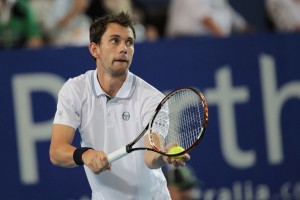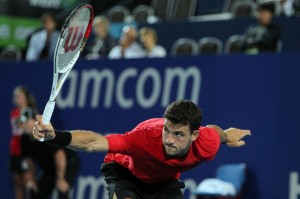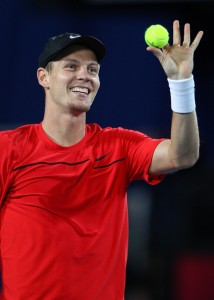Hopman Cup, 2012
As a high-profile exhibition tournament conducted a fortnight before the season’s first major, the Hopman Cup juggles the luxury of an invitational draw with the limitations imposed by the high number of alternative, officially-sanctioned events running in the same week. They can have any player they want, but the pickings might be slim. Coupled with the nation-based mixed team format, these factors invariably result in a broad cross-section of players, reflecting diverse rankings and abilities. The desire to have, say,  Li Na in attendance carries with it the reality that China has no male player of comparable stature. Consequently, a worldwide audience has been introduced to Wu Di, ranked No.421, as have his loftily-ranked opponents. The Danish contingent was similarly comprised: what tournament is going to turn down Caroline Wozniacki, even if she arrives packaged with the obscure and likeable Frederik Nielsen (ranked No.236)?
Li Na in attendance carries with it the reality that China has no male player of comparable stature. Consequently, a worldwide audience has been introduced to Wu Di, ranked No.421, as have his loftily-ranked opponents. The Danish contingent was similarly comprised: what tournament is going to turn down Caroline Wozniacki, even if she arrives packaged with the obscure and likeable Frederik Nielsen (ranked No.236)?
To the Hopman Cup’s credit, it never tries to downplay the ‘lesser’ players. Even in very strong years – both Andy Murray and Novak Djokovic turned up in 2011 – the event devotes considerable energy and airtime to showcasing both upcomers and perennial journeymen. Occasionally the former category yields gold, as in 2001 when the great Martina Hingis was paired with a largely unknown 19-year-old called Roger Federer. Paradorn Srichaphan’s introduction proved similarly auspicious, as did Jelena Dokic’s, among others. This year’s ‘find’ – at least far as the broader public is concerned – was Grigor Dimitrov. Naturally, anyone reading a tennis site is probably familiar with Dimitrov already, but the Hopman Cup is nothing if not broadly popular. (The frequent crowd shots suggest that most of those in attendance suggest the event is a popular stop along the grey nomad migratory routes. It is doubtful whether many of them knew much about Bulgaria’s greatest male player a week ago.  I suspect many could not locate the place on a map.) Furthermore, it has given the public the chance to see Dimitrov ply his trade against several top-ten players. It has proved to be an ideal opportunity for everyone to grow cheerfully acquainted.
I suspect many could not locate the place on a map.) Furthermore, it has given the public the chance to see Dimitrov ply his trade against several top-ten players. It has proved to be an ideal opportunity for everyone to grow cheerfully acquainted.
Dimitrov plied admirably against Tomas Berdych, whom he had actually beaten in their only previous meeting, and then more scratchily in overcoming Nielson. It was against Mardy Fish that he truly excelled, punishing the world No.8 6/2 6/1 in under an hour. For the wrong reasons, this is the match that is fated to endure, mostly due to Fish’s boorish outbursts. Aside from the protagonists themselves, no one knows exactly what was said between Fish and Dimitrov after their singles match, or during the subsequent mixed doubles tie. Both men have since maintained a raffish coyness under delicate questioning. Neil Harman put it to Fish via Twitter, but was rebuffed offhandedly. Fish is now crooning from the ATP Media Relations Songbook, insisting that Dimitrov is a great talent and has a bright future, artlessly glossing the fact that he’d looked eager to abbreviate that future just hours earlier. Pat Cash, who’d commentated on the match, later offered his opinion that Fish’s tirade owed mostly to sour grapes at losing so badly. Matt Cronin then upbraided Cash on Twitter, demanding why the Australian felt the need to comment at all, given he hadn’t heard precisely what was said. In other words, the teacup can no longer contain the tempest it spawned.
Regarding the last point, I would ask why Cash shouldn’t offer his opinion. Indeed, given his history of, and reputation for, effortless controversy, who really expected him not to? As a former great, it’s not as though he harbours any concern at upsetting Fish. And nor, by Cash’s lofty standards, did he essay anything especially contentious.  Does anyone realistically believe Fish would have acted the way he did had he been winning two and one? All it has really done is overshadow Dimitrov’s performance, which was almost flawless. A capricious god would have them meet in the first round of the Australian Open.
Does anyone realistically believe Fish would have acted the way he did had he been winning two and one? All it has really done is overshadow Dimitrov’s performance, which was almost flawless. A capricious god would have them meet in the first round of the Australian Open.
Positive, aggressive and the reigning Wimbledon champion, Petra Kvitova is surely the No.1 the WTA craves. In any case, assuming she maintains her current form in Melbourne, she is almost certainly the one it is going to get. She coasts a bare hundred points adrift of Wozniacki at No.2. Thus her pairing with Tomas Berdych this week saw them first awarded the top seeding, then subsequently the title. In between they beat everyone, including a reasonable French team in the final. Berdych and Gasquet fought out a skilful and entertaining first set, until the tiebreaker, at which point Berdych interleaved unreturnable serving with unservable returning. Gasquet alternated frustration and resignation, and couldn’t manage a point. The Czech moved ahead in the second set, blasting to 5/1, until Gasquet suddenly ascended to that rarefied locale he fleetingly visits, in which he cannot miss the court no matter how hard he swings. He fought back to 5/4, before Berdych closed it out. Both men should take much from the encounter, though only one of them will take a weird trophy home. Speaking of which, it turns out a diamond-encrusted tennis ball sounds classy in theory, but in practice looks much like a miniature disco ball. Still, the Czechs seemed pleased enough, doubtless envisaging many happy hours constructing tiny Saturday Night Fever dioramas. Or perhaps I’m projecting.
